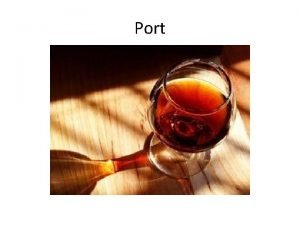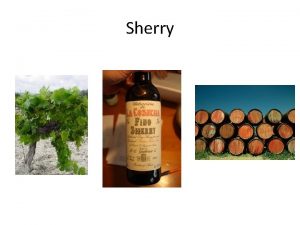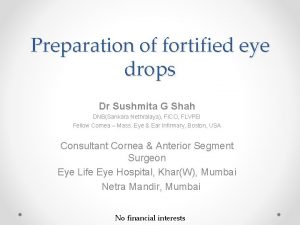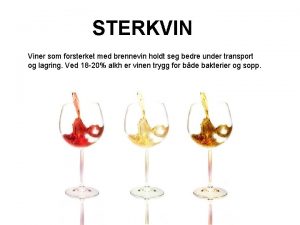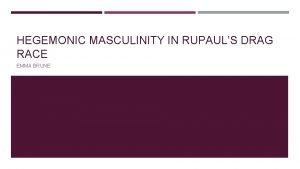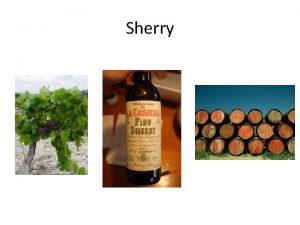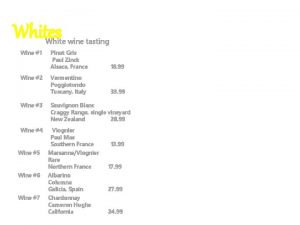Sherry Sherry is a fortified wine made from



















- Slides: 19

Sherry

• Sherry is a fortified wine made from white grapes that are grown near the town of Jerez de la Frontera in Andalusia, Spain.

• Sherry is produced in a variety of dry styles made primarily from the Palomino grape, ranging from light versions similar to white table wines, such as Manzanilla and Fino,

• to darker and heavier versions that have been allowed to oxidize as they age in barrel, such as Amontillado and Oloroso.

• In Europe, "Sherry" has protected designation of origin status, and under Spanish law, all wine labeled as "Sherry" must legally come from the Sherry Triangle • an area in the province of Cádiz between Jerez de la Frontera, Sanlúcar de Barrameda, and El Puerto de Santa María.

• The Palomino grapes are harvested in early September, and pressed lightly to extract the must.

• The must from the first pressing, the primera yema, is used to produce Fino and Manzanilla and the must from the second pressing, the segunda yema will be used for Oloroso ; the product of additional pressings is used for lesser wines, distillation and vinegar.

• The must is then fermented in stainless steel vats until the end of November, producing a dry white wine with 11 -12 percent alcohol content.

• After fermentation is complete, the base wines are fortified with grape spirit in order to increase their final alcohol content.

• Sherry is traditionally drunk from a copita, a special tulip-shaped Sherry glass.

• Wines classified as suitable for aging as Fino and Manzanilla are fortified until they reach a total alcohol content of 15. 5 per cent by volume

• Fino and Manzanilla are the most fragile types of Sherry and should usually be drunk soon after opening

• As they age in barrel, they develop a layer of flor—a yeast-like growth that helps protect the wine from excessive oxidation

• Those wines that are classified to undergo aging as Oloroso are fortified to reach an alcohol content of at least 17 per cent. They do not develop flor and so oxidize slightly as they age, giving them a darker color.

• Amontillados and Olorosos will keep for longer, while sweeter versions such as PX, and blended cream Sherries, are able to last several weeks or even months after opening, since the sugar content acts as a preservative.

Fortified Wine Type Alcohol % ABV Sugar content (grams per litre) Fino 15 -17 0– 5 Manzanilla 15 -17 0– 5 Amontillado 16 -17 0– 5 Palo Cortado 17 -22 0– 5 Oloroso 17 -22 0– 5 Dry 15 -22 5– 45 Pale Cream 15. 5 -22 45– 115 Medium 15 -22 5– 115 Cream 15. 5 -22 115 -140 Pedro Ximénez 15 -22 212+ Moscatel 15 -22 160+ Dulce / Sweet 15 -22 160+

• Wines from different years are aged and blended using a solera system before bottling, so that bottles of Sherry will not usually carry a specific vintage year and can contain a small proportion of very old wine.

• Sherry is aged in the solera for a minimum of 3 years.

• Once bottled, Sherry does not benefit from further aging and may be consumed immediately, though the sherries that have been aged oxidatively may be stored for years without losing their flavor. Bottles should be stored upright to minimize the wine's exposed surface area. As with other wines, Sherry should be stored in a cool, dark place.
 Portuguese fortified wine
Portuguese fortified wine A copita is a glass designed for this fortified wine
A copita is a glass designed for this fortified wine Fortified eye drops preparation
Fortified eye drops preparation Fortified bakery products industry
Fortified bakery products industry Define physical/natural boundary
Define physical/natural boundary Vitamin d fortified milk
Vitamin d fortified milk Homer's odyssey
Homer's odyssey Alone together sherry turkle
Alone together sherry turkle Sherry wynn
Sherry wynn Sherry velasco usc
Sherry velasco usc Cheri stephenson
Cheri stephenson Sherry
Sherry Sherry chan actuary
Sherry chan actuary Sherry og portvin
Sherry og portvin Life paths research center
Life paths research center Roberta bivins
Roberta bivins Sherry ebrahimi
Sherry ebrahimi Jill hornor
Jill hornor Ano ang pagkakaiba ng pakikilahok at bolunterismo?
Ano ang pagkakaiba ng pakikilahok at bolunterismo? Sherry turkle la vita sullo schermo
Sherry turkle la vita sullo schermo
